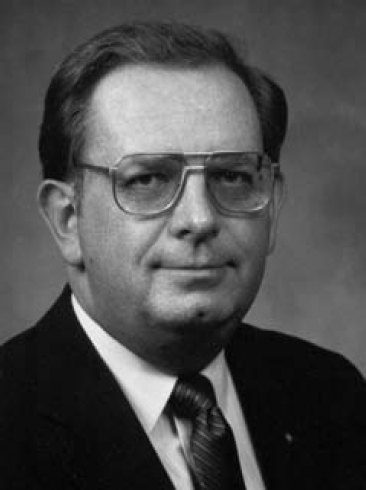
1936–2007
Elected in 1998
“For the development and applications of laser technology to space-based geodesy, atmospheric science, and communications.”
BY BILL D. CARROLL, FRANK L. LEWIS, AND JOHN J. MILLS SUBMITTED BY THE NAE HOME SECRETARY
JOHN H. McELROY—engineer, educator, and scientist—died of a heart attack at his home in Las Vegas, Nevada, on September 14, 2007, at the age of 71.
John was born on June 27, 1936, in Marion, Ohio. He attended elementary school and junior high in Marion and was well known in the local library from an early age. His hobbies were reading and football. John’s high school education was obtained at Culver Military Academy where he graduated in 1954 and entered the U.S. Army as a lieutenant. At Culver, John showed interests in English, history, science, art, and sports. He lettered in varsity baseball. His interest and preparation in these areas were certainly evident in his life and his work.
John served in the 11th airborne infantry unit in the United States and overseas until 1957. While serving in Germany, John met his future wife, Ellie, and they were married on March 18, 1957. From 1957 to 1963, he was senior instructor and technical writer at the U.S. Army Air Defense School, in Fort Bliss, Texas, and was twice named instructor of the year. In addition to teaching, John wrote several student texts that were translated into seven languages for use in the United States and abroad.
Following his military service, John enrolled in the University of Texas at Austin and earned a bachelor of science degree in electrical engineering in 1966. While pursuing his baccalaureate degree, John worked in the Quantum Electronics
Research Laboratory, where he did research on laser-induced ionization of high-pressure gases. Later he pursued graduate studies part time at Catholic University of America and earned a master’s of electrical engineering degree in 1973 and a Ph.D. in 1978.
John began a career with the National Aeronautics and Space Administration (NASA) in 1966 at the Goddard Space Flight Center. Over the years he served in various capacities at Goddard, including senior physicist and electronics engineer, head of the Laser Heterodyne Systems Section, and head of the Electro-Optics and Laser Technology branches. He directed research on laser communications systems, tracking and radiometry, and advanced satellite communications technology. From 1979 to 1980, John served as director of the Communications Division, Office of Space and Terrestrial Applications, at NASA Headquarters, where he directed the revitalization of NASA’s communications R&D program. John returned to Goddard in 1980 as deputy director and served in that capacity until 1982.
John served as the assistant administrator for satellites for the National Oceanic and Atmospheric Administration (NOAA) from 1982 to 1985. At NOAA he directed the national program in civil operational earth observation satellites, including responsibilities for Landsats-4 and -5, the Tiros series of polar-orbiting satellites, and the GOES series of geostationary satellites.
John joined Hughes Aircraft in 1985 as director of special projects for the Space and Communications Group. He served as vice president for technology of Hughes Communications from 1986 to 1987. While vice president, John led a corporate venture on mobile satellite communications that later became the American Mobile Satellite Corporation. During this time period, he was also senior editor of Space Science and Applications, a publication of the Institute of Electrical and Electronics Engineers’ Aerospace and Electronic Systems Society.
From 1987 to 1996, John served as dean of the College of Engineering at the University of Texas at Arlington, overseeing
a sustained period of growth in both student enrollment and research programs. He then served as UT Arlington’s vice provost for research and as dean of graduate studies from 1996 to 1997. He returned to the classroom, teaching electrical and industrial engineering courses until his retirement in May 2000.
A noted authority on space sciences, John was frequently called on to serve as an advisor on investigatory committees and commissions. He was a member of the Space Studies Board of the National Academies and the Advisory Committee on the Future of U.S. Space Programs and coauthored the Center for Strategic and International Studies report A More Effective Civil Space Program with co-chair Brent Scowcroft.
John was recognized by several professional organizations for his technical knowledge and service. He was a fellow of the Institute of Electrical and Electronics Engineers, the American Institute of Aeronautics and Astronautics (AIAA), and the Washington Academy of Sciences and a member of the National Academy of Engineering. In addition, he was presented with a NASA First Space Shuttle Flight Achievement Award and Medallion, a NASA Apollo Achievement Award and Medallion, a Silver Medallion from the Brazilian Institute for Space Research, a Bronze Medallion from the Soviet Merchant Marine, and the German Space Agency Medallion (for founding and chairing the International Committee on Earth Observation Satellites). In 1997, AIAA awarded John the International Cooperation Award “for creative leadership in the planning, negotiation, and execution of international participation in major U.S. Space Applications Programs.”
John was deeply respected and highly regarded for his personal values and the sense of warmth and friendship that he shared with all who knew him. He was above all a person of integrity and high standards.
John is survived by his wife, Eleonore (Ellie) McElroy. They were a devoted and inseparable couple over the 50 years of their marriage.
John is buried at the Veterans Memorial Cemetery in Boulder City, Nevada.




